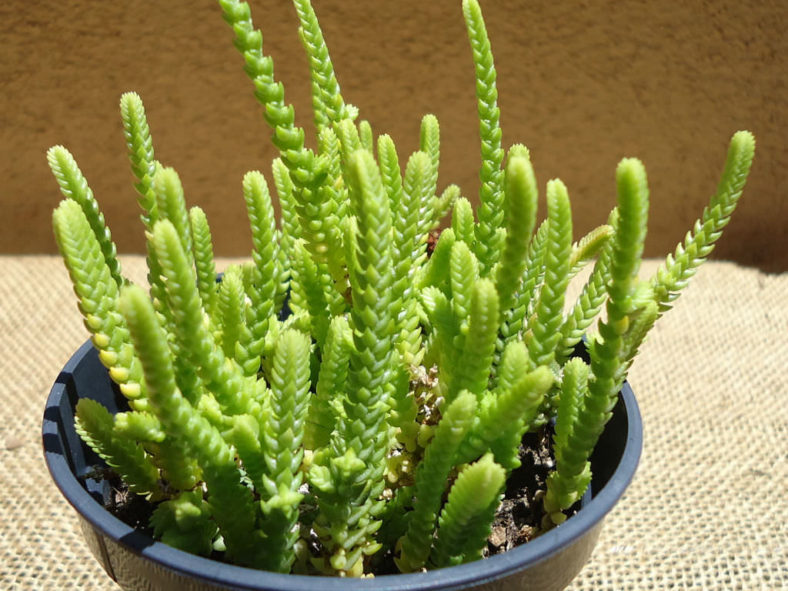Crassula muscosa is an interesting succulent that grows up to 12 inches (30 cm) tall with a spreading habit of branching stems with tightly overlapping, stacked, narrow, light green leaves that entirely hide the stems. The stems start erect but then trail over from the weight of the leaves. The small, pale yellowish-green, musty-smelling flowers appear along with the leaves tightly along the stems from spring to mid-summer. This succulent is excellent for adding a unique texture to a mixed planting or small-scale ground cover in a well-drained mound or rock garden.
The most common name for this plant is Watch Chain for its delicate interlocking leaves, much like the tight jewelers' links used to attach a pocket watch to the vest. It is also called Princess Pine, Clubmoss Crassula, Zipper Plant, and Rattail Crassula. The specific epithet "muscosa" is Latin for "mossy" and refers to this plant's moss-like appearance. It has also been called Crassula lycopodioides in reference to the plant being like Lycopodium, a genus of Clubmoss.
Watch Chain comes from diverse habitats and is widespread in South Africa, from the winter rainfall area of the Western Cape to the summer rainfall areas of the Eastern Cape and north into Namibia and Lesotho, though often growing only in well-drained rocky quartz fields. It is hardy to around 20 °F (−6.7 °C) but seems to resent being cold and wet at the same time.

Growing Conditions and General Care
Plant in well-drained soil in full sun to light shade or indoors. If planting indoors, place it in a room with a lot of sunlight. The best color is maintained with a bit of shade, even on the coast.
Watch Chain has typical watering needs for a succulent. It is best to use the "soak and dry" method, allowing the soil to dry out completely between waterings.
Since Watch Chain is not cold-hardy, it should be brought indoors when the temperature falls below 20 °F (-6.7 °C).
The plants should be feed with a controlled-release fertilizer during the growing season. It can be feed weekly with a weak liquid solution.
While in summer, it needs a lot more water, and it should not be exposed to full sun, as it only values brightness but would suffer under excessive sunlight. When these conditions are not met, the plant begins to dry and stiffen, generally starting from the base of the stem up to the tips.
Repotting
Watch Chain should be repotted during the warm season. It should ensure the soil is dry while repotting the plant. Any old soil must be shaken off the roots before planting the plant in a new pot. Any dry or damaged roots should also be discarded in the process.
Propagation
Watch Chain is an invasive species and easily propagates from stem cuttings. However, if the environment maintains a stable temperature of 68 to 70 °F (20 to 21 °C), the cutting will root and grow rapidly with adequate humidity and brightness.
Pests and Diseases
Watch Chain is vulnerable to typical diseases, such as mealybug invasions and fungal diseases. In addition, overwatering may cause the roots to rot.
Links
- Back to genus Crassula
- Succupedia: Browse succulents by Scientific Name, Common Name, Genus, Family, USDA Hardiness Zone, Origin, or cacti by Genus